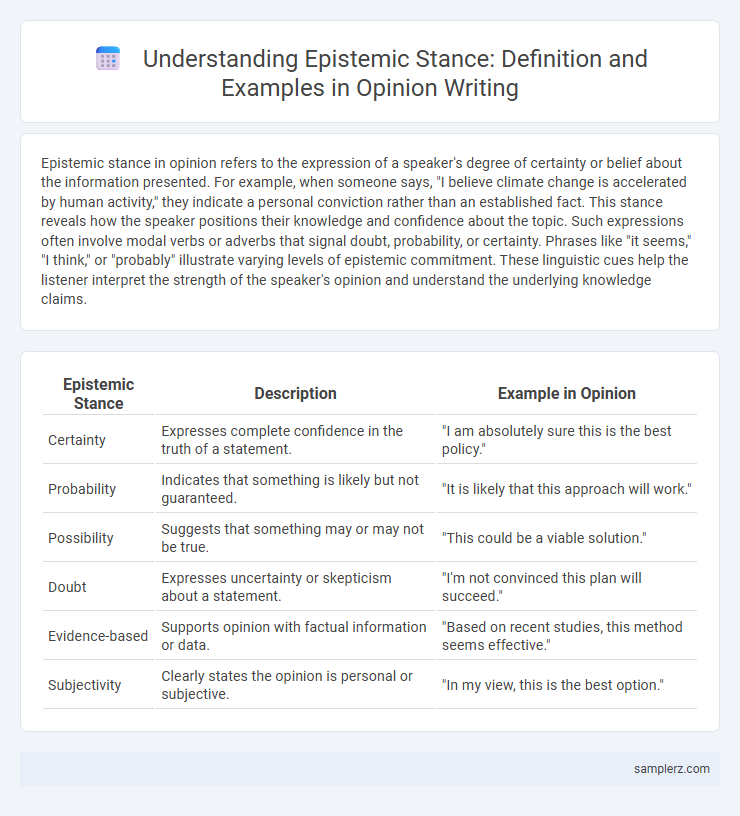Epistemic stance in opinion refers to the expression of a speaker's degree of certainty or belief about the information presented. For example, when someone says, "I believe climate change is accelerated by human activity," they indicate a personal conviction rather than an established fact. This stance reveals how the speaker positions their knowledge and confidence about the topic. Such expressions often involve modal verbs or adverbs that signal doubt, probability, or certainty. Phrases like "it seems," "I think," or "probably" illustrate varying levels of epistemic commitment. These linguistic cues help the listener interpret the strength of the speaker's opinion and understand the underlying knowledge claims.
Table of Comparison
| Epistemic Stance | Description | Example in Opinion |
|---|---|---|
| Certainty | Expresses complete confidence in the truth of a statement. | "I am absolutely sure this is the best policy." |
| Probability | Indicates that something is likely but not guaranteed. | "It is likely that this approach will work." |
| Possibility | Suggests that something may or may not be true. | "This could be a viable solution." |
| Doubt | Expresses uncertainty or skepticism about a statement. | "I'm not convinced this plan will succeed." |
| Evidence-based | Supports opinion with factual information or data. | "Based on recent studies, this method seems effective." |
| Subjectivity | Clearly states the opinion is personal or subjective. | "In my view, this is the best option." |
Defining Epistemic Stance in Opinion Articles
Epistemic stance in opinion articles reflects the writer's degree of certainty and the strength of their knowledge claims, indicating how confidently they present their viewpoints. Expressions such as modal verbs ("might," "must"), adverbs ("probably," "clearly"), and evidential phrases ("according to research," "it seems") serve to modulate the writer's commitment to the truth of their statements. This nuanced positioning shapes readers' perception of credibility and encourages critical engagement with the arguments presented.
Types of Epistemic Stances in Personal Opinions
Epistemic stances in personal opinions often manifest as degrees of certainty, such as asserting knowledge with confidence or expressing doubt through hedging language. Types include claims of direct knowledge, informed inference, and belief-based perspectives, each signaling varying levels of commitment to the truth of a proposition. These stances shape how opinions are presented and influence their persuasive impact in discourse.
How "I Believe" Signals Epistemic Positioning
The phrase "I believe" clearly signals an epistemic stance by expressing the speaker's personal commitment to the truth of a proposition without claiming absolute certainty. It frames the opinion as subjective, allowing space for alternative viewpoints and indicating a degree of tentativeness. This linguistic marker thus situates the speaker's knowledge as interpretative and open to revision.
Hedging and Certainty: Epistemic Markers in Opinions
Epistemic stance in opinions frequently employs hedging through phrases like "it seems," "possibly," or "likely," which signal uncertainty and openness to alternative interpretations. Certainty is communicated with definitive markers such as "definitely," "clearly," and "undeniably," reinforcing the speaker's confidence in their claim. These epistemic markers strategically manage perceived knowledge strength, influencing how opinions are received and evaluated by audiences.
Expressing Doubt: Examples of Epistemic Modality
Expressing doubt in opinion often involves using epistemic modality to convey uncertainty or hesitation, such as modal verbs like "might," "could," and "may." Phrases like "It seems possible that" or "There is a chance that" illustrate this stance by indicating a lack of full commitment to the truth of the statement. Such linguistic markers highlight the speaker's cautious approach to knowledge claims and signal openness to alternative interpretations.
The Role of Evidence in Stating Opinions
Epistemic stance in opinion highlights the crucial role of evidence in shaping and expressing beliefs, ensuring claims are backed by verifiable data rather than mere speculation. Speakers demonstrate confidence levels by citing empirical research, expert testimony, or statistical analyses to validate their viewpoints. This approach fosters credibility and allows audiences to assess the reliability and strength of the opinions presented.
Comparing Facts and Assumptions in Epistemic Stance
Comparing facts and assumptions in epistemic stance reveals how opinions are grounded in different levels of certainty and evidence. Facts provide verifiable data that support claims, while assumptions rely on unverified beliefs or interpretations, affecting the strength and credibility of an argument. Recognizing this distinction enables a more critical evaluation of opinions and their underlying knowledge claims.
Authorial Voice: Confidence versus Uncertainty
Epistemic stance in opinion often reveals itself through the author's voice, balancing confidence and uncertainty to influence readers' trust. Clear, assertive language signals strong authorial confidence, enhancing credibility and persuasiveness. In contrast, hedging phrases like "might suggest" or "possible that" convey uncertainty, inviting readers to consider alternative viewpoints and fostering openness.
Reader Perception of Epistemic Stance in Opinions
Epistemic stance in opinions shapes how readers evaluate the credibility and certainty of a statement, influencing their trust and engagement with the text. For example, modal verbs like "might" or "must" signal varying degrees of certainty, guiding readers to interpret an opinion as tentative or confident. Readers often align their agreement or skepticism based on these linguistic cues that reflect the author's knowledge or belief strength.
Strategies for Strengthening Epistemic Stance in Writing
Employing modal verbs like "might," "could," and "seems" enhances epistemic stance by conveying degrees of certainty and openness to alternative interpretations. Integrating hedging techniques, such as using cautious language and disclaimers, allows writers to present opinions while acknowledging potential limitations or gaps in knowledge. Explicitly referencing credible sources and evidence further solidifies the writer's epistemic positioning, fostering trust and intellectual humility in opinion writing.

example of epistemic stance in opinion Infographic
 samplerz.com
samplerz.com